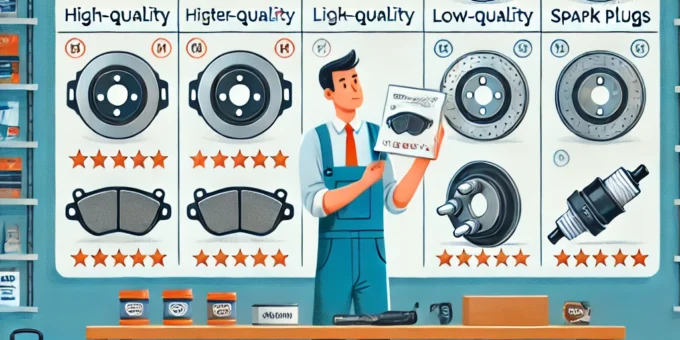
When your car needs repairs or maintenance, using high-quality replacement parts is essential for ensuring safety, performance, and longevity. However, with so many options on the market—from original equipment manufacturer (OEM) parts to aftermarket alternatives—it can be overwhelming to determine which parts are reliable and worth your money.
This guide will teach you how to identify high-quality car parts for replacement, covering the differences between OEM and aftermarket parts, where to shop, and tips for avoiding low-quality or counterfeit components.
Why Using High-Quality Parts Matters
Choosing high-quality car parts has several advantages:
- Improved Safety: Faulty or low-quality parts can lead to accidents or mechanical failure.
- Better Performance: Genuine, well-made parts ensure your car runs as it should.
- Longer Lifespan: High-quality parts are more durable and reduce the need for frequent replacements.
- Cost Savings: While initially more expensive, quality parts prevent costly repairs down the road.
Pro Tip: Avoid the temptation to save a few dollars by purchasing inferior parts—it could cost you much more in the long run.
OEM vs. Aftermarket Parts: What’s the Difference?
Understanding the key types of car parts will help you make an informed decision.
- OEM (Original Equipment Manufacturer) Parts:
- Made by the same manufacturer as the original part installed in your car.
- Guaranteed to fit and perform as intended.
- Typically more expensive than aftermarket parts.
- Aftermarket Parts:
- Made by third-party manufacturers.
- Often less expensive and may offer more variety.
- Quality varies greatly, so research is essential.
- Refurbished or Remanufactured Parts:
- Used parts that have been restored to working condition.
- Usually cheaper but may not last as long as new parts.
Tip: Choose OEM parts for critical components like brakes or airbags, and use high-quality aftermarket parts for less critical items like filters or wiper blades.
Step 1: Understand Your Car’s Requirements
Your car’s owner’s manual is your go-to resource for understanding the specifications of replacement parts.
What to Look For:
- Part Numbers: Ensure compatibility by matching part numbers.
- Material Requirements: For example, brake pads may specify ceramic, semi-metallic, or organic materials.
- Brand Recommendations: Some manuals list preferred brands or types of parts.
Tip: If you’re unsure, consult a trusted mechanic or parts specialist.
Step 2: Shop at Trusted Retailers
Always purchase car parts from reputable sources to avoid counterfeit or low-quality products.
Reliable Options:
- Authorized Dealerships: Best for OEM parts.
- Reputable Online Retailers: Examples include RockAuto, AutoZone, and CARiD.
- Local Auto Parts Stores: Trusted local businesses often offer expert advice.
Red Flags:
- Retailers offering prices that seem “too good to be true.”
- Poorly designed websites or suspicious payment methods.
Step 3: Look for Certifications and Standards
Certifications indicate that a part meets safety and quality standards.
Key Certifications to Look For:
- ISO Certification: Ensures that the manufacturer follows international quality standards.
- DOT (Department of Transportation): Required for safety-critical components like lighting and brakes.
- CAPA (Certified Automotive Parts Association): Indicates that aftermarket parts meet strict performance and safety standards.
Step 4: Verify the Manufacturer’s Reputation
Research the brand or manufacturer before purchasing a part.
How to Research:
- Read online reviews and customer feedback.
- Look for established brands with a long history of reliability.
- Avoid manufacturers with a high rate of complaints or negative reviews.
Top-Rated Part Manufacturers:
- Bosch, Denso, ACDelco (for engine components).
- Brembo (for brakes).
- NGK (for spark plugs).
Step 5: Inspect the Part’s Quality
Before installing a part, check for signs of high-quality manufacturing.
What to Inspect:
- Material and Finish: Parts should feel sturdy, with no visible defects or rough edges.
- Weight: Genuine parts often weigh more than counterfeit or low-quality parts.
- Packaging: Authentic parts typically come in branded, professional packaging.
Tip: Compare the new part with the one being replaced to ensure a proper match.
Step 6: Check Warranty and Return Policies
A good warranty is often a sign of a quality product.
What to Look For:
- Length of Coverage: High-quality parts often come with longer warranties (e.g., 1 year or more).
- Return Policy: Ensure the retailer offers hassle-free returns if the part doesn’t fit or perform as expected.
Step 7: Avoid Counterfeit and Substandard Parts
Counterfeit parts are a significant problem in the auto industry, and they can compromise your car’s safety.
How to Spot Fake Parts:
- Misspelled brand names or logos on the packaging.
- Low-quality materials or finishes.
- Absence of a serial or part number.
Tip: Buy directly from authorized dealers or trusted retailers to reduce the risk of counterfeit products.
Step 8: Work with a Trusted Mechanic
A knowledgeable mechanic can help you source and verify high-quality parts.
Benefits of Working with a Mechanic:
- They can recommend reliable brands and suppliers.
- They may have access to wholesale pricing or discounts.
- They’ll ensure the part is installed correctly.
Tip: Always ask for your old part back after it’s replaced to verify that the repair was completed.
When to Use Aftermarket Parts
Aftermarket parts can be a good choice in these scenarios:
- Non-Critical Components: For items like air filters, wiper blades, or cosmetic parts.
- Cost Savings: High-quality aftermarket parts are often cheaper than OEM parts.
- Upgrades: Some aftermarket parts offer better performance or customization options than OEM parts.
Common Mistakes to Avoid
- Choosing the Cheapest Option: Low prices often mean low quality.
- Ignoring Specifications: Always match parts to your car’s requirements.
- Skipping Research: Take time to verify the manufacturer and retailer.